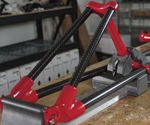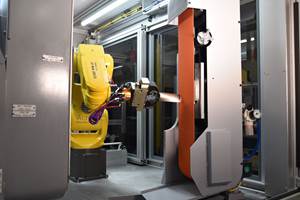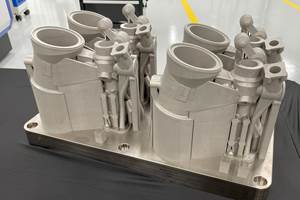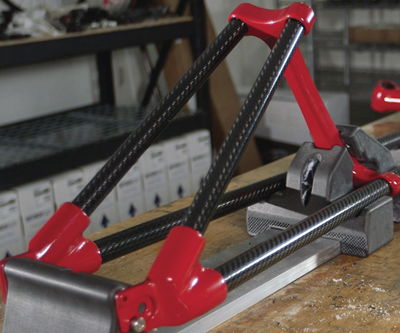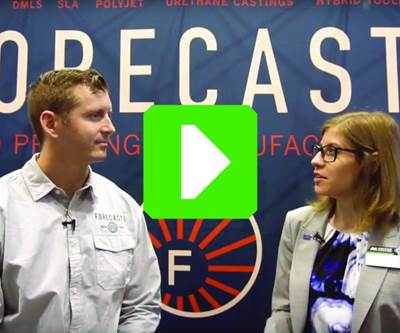Diabase Brings a Machine Tool Perspective to FDM
The company’s H-series Additive and Hybrid systems take inspiration from machining centers to unlock the potential of filament-based 3D printing.
At a first glance, one of Diabase’s H-series machines might register as a desktop mill as opposed to a 3D printer. The rotary fourth axis, a toolhead that moves only in the Z axis and 10-position toolchanger seem reminiscent of a vertical machining center more than anything else. But look closer and you’ll see that the rotary table is designed to accommodate a build platform. The toolhead is directly connected to a filament drying cabinet. And that toolchanger? Up to five of its 10 positions can be equipped with 3D printing extruders.
“We wanted to take advantage of the capabilities that we knew were possible and basically unlock the potential of FDM with this printer,” says Austin Reid, cofounder of the company together with Stephen Heston. Diabase grew out of a consulting business and in 2015 became the manufacturer of the Flexion Extruder, an filament extruder that uses a direct-drive setup and short compression path to minimize friction loss and provide a more reliable filament printing process.
From there, it was a short leap into developing a full-scale FDM system that could take advantage of the benefits of this extruder. Reid and Heston also had an added objective to solve some of the problems of filament-based 3D printing, including material limitations, support structure and build orientation challenges, and poor surface finish, among others. These ideas have evolved into Diabase’s H-series machines, which are launching in a limited run to early adopters (find more information about how to participate on the Diabase website).
The series consists of an Additive model for 3D printing only and a Hybrid model that enables milling as well as printing. The platform supports multimaterial 3D printing with durable urethanes in as many as five axes, and in the case of the Hybrid platform, enables users to address surface finish concerns with finish machining.
“A machine tool is multifunctional. There are specific processes that it is setup to do very well, but there are also ways you can configure it to do something very complex. That’s the mentality that we brought to the design of this machine.”
Both Heston and Reid come from machining backgrounds, and that experience is evident in the machine design. “A machine tool is multifunctional,” Heston says. “There are specific processes that it is setup to do very well, but there are also ways you can configure it to do something very complex. That’s the mentality that we brought to the design of this machine.”
Some of those specific processes that the H-series is optimized for include simplified setup for printing from scratch, ease of switching from printing to milling, and the ability to print with a rotary axis. Each printer is equipped with a touch probe that automatically captures a contour of the print bed before the cycle to enable the printer to compensate. In a hybrid process that switches from printing to milling, there’s no need to touch off reference points because the printer retains the coordinates of the printed stock. While most filament-based printers operate only in three axes, Diabase’s rotary axis makes it possible to build onto round stock, for instance adding a grip to the shaft of a golf club, or access a part from multiple angles.
In one recent example, the rotary table was used to manufacture a snowboard rack in a single setup. The company placed a sheet of machine-grade ABS in a window-frame fixture in the rotary axis, milled the outline of a part leaving tabs to hold it in place, cut fillets and contours with a ball end mill, and then 3D-printed an elastomer material onto the part to provide padding. Watch the process in the video below:
The rotary axis has the added benefits of reducing need for support structures and enabling more complex geometries. “If you can use a cylindrical motion system and build outward from the axis of rotation, it reduces the need for support material and gives the part the strength you want in the right directions,” Heston says.
Certain pieces of the system are still in development, primarily the software that will support more complex manufacturing strategies. Currently the H-Series machines use a standard slicing package but with intermediate steps that include “unwrapping” the part, slicing it, and then rewrapping the tool paths in order to generate the G code to drive the print, Heston says. Five-axis tool paths are not yet available, but this is one goal the company is working toward.
Further development will focus on the introduction of new capabilities like different deposition or subtractive processes, as the printer’s open layout makes it easier to access and incorporate new modules as they become available. “It’s a mechanical system that is designed to be expanded on, very much like a machine tool,” Heston says. “You don’t have to know everything that you’re going to want to do with it when you initially purchase it.”
The H-series systems are designed with an eye toward production and intended for the “border area” that exists between consumer and industrial, Heston says. Diabase sees its machines being used by small companies making shorter runs and high-value products, such as custom footwear, sporting goods and luxury items. The H-Series also has obvious applications for prototyping and product development, enabling design houses to make parts from durable materials and machine them to a better surface finish than FDM alone. Diabase also sees a prosumer market for users with a certain level of engineering and manufacturing knowledge. “There are some customers that we expect to be interested in it for their own use—people who would have a Bridgeport mill and some machining equipment in their garage, or engineers who are also doing engineering work in their spare time,” Heston says.
Related Content
Top 10 Additive Manufacturing Stories of 2023
Laser powder bed fusion, proprietary AM processes, machining and more made our list of top 10 articles and videos by pageviews this year.
Read MoreAircraft Engine MRO: How Additive Manufacturing Plus Robotic Finishing Will Expand Capacity for Blade Repair
AM offers the chance to bring fast, automated processing to individualized, part-by-part restoration of turbomachinery. A cell developed by Acme Manufacturing and Optomec is able to automatically repair 85,000 unique aircraft engine blades per year.
Read MoreWhy AM Leads to Internal Production for Collins Aerospace (Includes Video)
A new Charlotte-area center will provide additive manufacturing expertise and production capacity for Collins business units based across the country, allowing the company to guard proprietary design and process details that are often part of AM.
Read MoreAM 101: What Is Hot Isostatic Pressing (HIP)? (Includes Video)
Hot isostatic pressing has long been used for metal castings, but is now being applied as a valuable method for closing porosity in metal 3D printed parts.
Read MoreRead Next
3D-Printed Prototypes Become the Parts with Carbon Fiber Filled Filament
Utah Trikes, a retailer and manufacturer of trikes and quads, has grown its custom business using FDM Nylon 12CF to produce end-use composite parts that formerly would have required moldmaking.
Read MoreVideo: 3D Printing Is a Complement and Competitor to Injection Molding
Ken Burns of Forecast 3D, an early adopter of HP Multi Jet Fusion, sees 3D printing as both a complement and a competitor to injection molding. He shares why in this interview.
Read More3D Printing Brings Sustainability, Accessibility to Glass Manufacturing
Australian startup Maple Glass Printing has developed a process for extruding glass into artwork, lab implements and architectural elements. Along the way, the company has also found more efficient ways of recycling this material.
Read More
.jpg;width=70;height=70;mode=crop)
